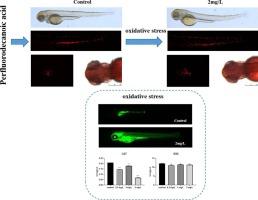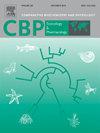全氟癸酸通过上调氧化应激水平诱导斑马鱼胚胎中先天性细胞的增加。
IF 3.9
3区 环境科学与生态学
Q2 BIOCHEMISTRY & MOLECULAR BIOLOGY
Comparative Biochemistry and Physiology C-toxicology & Pharmacology
Pub Date : 2024-09-07
DOI:10.1016/j.cbpc.2024.110037
引用次数: 0
摘要
一些研究报告指出,全氟烷基和多氟烷基物质(PFASs)的广泛使用导致环境污染加剧,进而影响水生生物。据报道,全氟辛烷磺酸(PFOS)和全氟辛酸(PFOA)等全氟烷基物质会对不同生物造成心脏毒性、神经毒性和发育毒性。然而,作为一种广泛使用的全氟烷基物质,全氟癸酸(PFDA)是否会诱发动物胚胎发育毒性仍是未知数。在此,我们通过 RNA 测序、形态学评估和行为改变检测,探讨了斑马鱼胚胎在暴露于 0.5、1 和 2 mg/L PFDA 后的免疫毒性和相关机制。有趣的是,我们发现随着 PFDA 药物浓度的增加,包括中性粒细胞和巨噬细胞在内的固有细胞数量、免疫相关基因的表达量都显著增加。此外,经 PFDA 处理的胚胎中氧化应激以剂量依赖的方式增加,而抑制氧化应激水平可有效挽救中性粒细胞的数量。暴露于 PFDA 后,胚胎行为也发生了变化。总之,我们的研究结果表明,在斑马鱼的早期发育阶段,PFDA 可能会通过氧化应激的积累诱导先天性免疫反应,因此需要关注其环境暴露对动物胚胎发育的风险。环境意义:全氟和多氟烷基物质(PFASs)是一类含氟的合成有机化合物,被广泛用作润滑剂、表面活性剂、杀虫剂等。PFDA 是一种典型的全氟化合物,在工业中常被用作润湿剂和阻燃剂。多项研究表明,全氟辛烷磺酸会造成严重的环境污染,导致各种动物的发育毒性,包括生殖毒性、肝脏毒性、心脏毒性、神经毒性和免疫毒性。然而,有关全氟辛烷磺酸对水生生物的影响和机制的研究仍然有限。因此,有必要对全氟辛烷磺酸在动物体内的生态风险进行评估。本文章由计算机程序翻译,如有差异,请以英文原文为准。

Perfluorodecanoic acid induces the increase of innate cells in zebrafish embryos by upregulating oxidative stress levels
Several studies reported that the widespread use of perfluoroalkyl and polyfluoroalkyl substances (PFASs) causes increased environmental pollution, subsequently impacting aquatic organisms. Perfluoroalkyl substances such as perfluorooctane sulfonic acid (PFOS) and perfluorooctanoic acid (PFOA) reportedly cause cardiotoxicity, neurotoxicity, and developmental toxicity in different organisms. However, whether perfluorodecanoic acid (PFDA), a widely used perfluoroalkyl substance, induces animal embryos developmental toxicity remain unknown. Here, we explored the immunotoxicity and associated mechanisms of PFDA in zebrafish embryos via RNA sequencing, morphological assessment and behavioral alteration detection following exposure to 0.5, 1 and 2 mg/L of PFDA. Interestingly, We found that with the increase of PFDA to drug concentration, including neutrophils and macrophages, significantly increased the number of inherent cells, immune related genes expression. Furthermore, oxidative stress increased in the PFDA-treated embryos in a dose-dependent manner and inhibition of oxidative stress levels effectively rescued the number of neutrophils. Changes in embryonic behavior were observed after exposure to PFDA. Overall, our results suggest that PFDA may induce innate immune response by accumulation of oxidative stress in zebrafish at early developmental stages, and concern is needed about its environmental exposure risks for animals embryos development.
Environmental implication
Perfluorinated and polyfluorinated alkyl substances (PFASs) are a class of synthetic organic compounds containing fluorine widely used as lubricants, surfactants, insecticides, etc. The PFDA, a typical perfluorinated compound, is often used as a wetting agent and flame retardant in industries.
Several studies showed that PFASs can cause serious environmental pollution, leading to developmental toxicity to various animals, including reproductive toxicity, liver toxicity, heart toxicity, neurotoxicity, and immunotoxicity.
However, there are still limited studies on the effects and mechanisms of PFDA on aquatic organisms. Therefore, there is a need to evaluate the ecological risks of PFDA in animals.
求助全文
通过发布文献求助,成功后即可免费获取论文全文。
去求助
来源期刊
CiteScore
7.50
自引率
5.10%
发文量
206
审稿时长
30 days
期刊介绍:
Part C: Toxicology and Pharmacology. This journal is concerned with chemical and drug action at different levels of organization, biotransformation of xenobiotics, mechanisms of toxicity, including reactive oxygen species and carcinogenesis, endocrine disruptors, natural products chemistry, and signal transduction with a molecular approach to these fields.

 求助内容:
求助内容: 应助结果提醒方式:
应助结果提醒方式:


